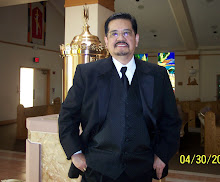This also happened at a special mass which was celebrated for our group of pilgrims in the chapel underneath the Basilica of the Poor Clares of Perpetual Adoration- the Our Lady of the Angels Monastery, a mass in pre- Vatican II style.
 |
| Latin Mass |
As kids, we used to attend Catholic mass at the Sta. Ana Church near Panaderos. The mass was still in Latin and women wore veils and had missalettes. From time to time, the parish priest scaled the steps leading to the pulpit from where he gave his Sunday homily.
Sta. Ana Church is an old church having been established in 1578 and its architecture and history added magnificence to the masses celebrated there. But today, all masses are celebrated facing the parishioners.
As a converted Catholic, I thought that the mass orientation of today has something to do with Vatican II and that all masses should be celebrated facing the congregation. But further research told otherwise.
 |
| Priest celebrates mass "ad orientem," facing the altar |
A mass celebrated facing the altar is called "ad orientem," or facing east, and a mass celebrated facing the congregation is called "versus populum" orientation.
The present-day Roman Missal does not forbid the ad orientem position for the priest when saying Mass and only requires that in new or renovated churches the facing-the-people orientation be made possible: "The altar should be built apart from the wall, in such a way that it is possible to walk around it easily and that Mass can be celebrated at it facing the people, which is desirable wherever possible."
I find the "versus populum" orientation very welcoming and inclusive but I also remember the Latin masses of my childhood very appealing and holier.
 |
| Pope Benedict XVI celebrated mass "ad orientem" at the Sistine Chapel |
 |
| St. James Cathedral in Seattle, Washington. |
At the end of the day, whether "ad orientem or versus populum" orientation, the appeal of going to mass rests heavily on the priest celebrating it and the one giving the homily.
While Jesus Christ is the Host of the Mass, the priest is the celebrant whose great task is to make the people feel the love of Christ through him.










